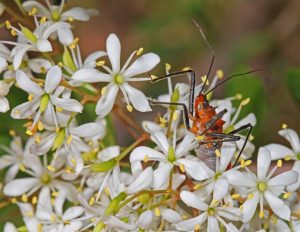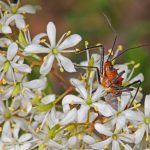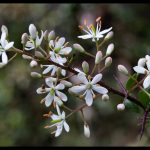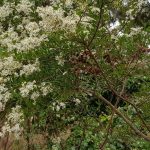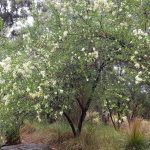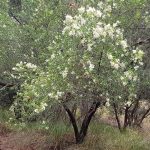Gardening with Indigenous Plants
Indigenous Plant Use
Identification & Control of Common Weeds
| Botanical Name: | Bursaria spinosa synonym: Bursaria spinosa var. normalis |
| Common Name: | blackthorn, boxthorn, kurwan (d'harawal), sweet bursaria, tupy |
| Sold As: | Tube ($2.00) |
| Plant Type(s): | Tall Shrub (2 to 6 m), Bee Attracting, Bird Attracting, Butterfly Attracting, Insect Attracting |
| Growing Conditions: | Full Sun, Partial Shade
Dry, Well Drained |
| Size (HxW): | 6 m x 3 m |
| Foliage: | Shiny narrow dark green leaves to 2.5cm long x 1cm wide. Smaller leafed in drier sites and larger leafed and often spineless in moist sites. |
| Flowers: | Fragrant creamy-white flowers, clustered at the end of branches from December to March. Bronze seed capsules follow after flowering. |
| General Comments: | Slender to rounded shrub or small tree with prickly spines along branches. Prune when young to encourage a bushy growth. Drought, frost, snow and lime tolerant. Its thorny habit provides a good refuge for birds. From LA TROBE UNIVERSITY (Nangak Tamboree Wildlife Sanctuary): Sweet Bursaria has a close, symbiotic relationship with the threatened Eltham Copper Butterfly (Paralucia pyrodiscus lucida) and ants from the genus Notoncus. Adult butterflies lay their eggs on the roots and stems of Sweet Bursaria. The ants guard the caterpillars (providing protection from predators) ushering the larvae to and from the ant nest at the base of the plant to feed on the leaves at night. In return, the caterpillars excrete a sugary substance which the ants feed on. |
 Further Information: |
This image by Bill Higham, has licence: CC BY-NC-ND 2.0 <https://creativecommons.org/licenses/by-nd-nc/2.0/jp/>

